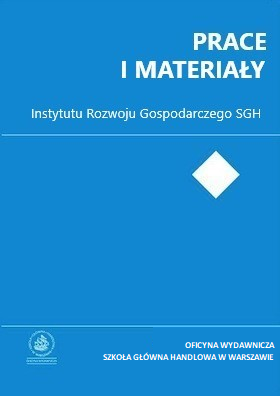Stylised Facts in Cyclical Fluctuations of Business Survey Data
##plugins.themes.bootstrap3.article.main##
Abstrakt
The paper discusses cyclical fluctuations of business activity in selected sectors of the Polish economy, with the use of business confidence indicators. We analyse main morphological features of the cyclical fluctuations: phase duration, timing of turning points, amplitudes, intensity and leads/lags of qualitative indicators in reference to GDP, and cross-correlations. Four sectors of the economy are analysed: manufacturing, construction, motor transport and retail trade. We make an insight into empirical regularities of cyclical fluctuations, known as stylised facts. We particularly aim to examine the following stylised facts about business cycles in Poland, ie (1) whether manufacturing contributes the highest to a business cycle, (2) construction and transport are leading sectors of the economy, and (3) retail sales stabilise general business activity.(original abstract)
##plugins.themes.bootstrap3.article.details##
Bibliografia
Adamowicz, E., Dudek, S., Pachucki, D., Walczyk, K. (2008). Synchronizacja cyklu koniunkturalnego polskiej gospodarki z krajami strefy euro w kontekście struktury tych gospodarek [Synchronisation of business cycles in Poland with Euro Area business cycles in the context of the economies’ structures]. Appendix to Raport na temat pełnego Uczestnictwa Rzeczypospolitej Polskiej w trzecim etapie Unii gospodarczej i walutowej [Report on Poland’s full participation in the 3rd stage of Economic and Monetary Union]. Warsaw: NBP.
Adamowicz, E., Walczyk, K. (2012). Fakty empiryczne w danych jakościowych. Z badań koniunktury IRG SGH [Stylised facts in data out of RIED business cycle research]. Prace i Materiały Instytutu Rozwoju Gospodarczego, 90, 39-65.
Altug, S. G. (2010). Business cycles. Fact, fallacy and fantasy. Singapur: World Scientific.
Ando, A., Modigliani, F. (1957). Tests of the life cycle hypothesis of saving: Comments and suggestions. Oxford Institute of Statistic Bulletin, 99-124.
Burns, A. F., Mitchell, W. C. (1946). Measuring business cycles. New York: NBER.
European Commission (2007). The joint harmonized EU programme of business and consumer surveys. User guide. Brussels: EU.
Friedman, M. (1957). A theory of the consumption function. New York: NBER.
Harding, A. D. (2003). Essays on the business cycles. ProQuest Information and Learning Company.
Klein, P. A., Moore, G. H. (1985). Monitoring growth bycles in market-oriented countries. Developing and using international economic indicators. Studies in Business Cycles, 26.
Klimkowska, J., Stolorz S. (2008). Własności prognostyczne barometru koniunktury IRG SGH i jego składowych w oparciu o składnik referencyjny wahań cyklicznych dla gospodarki polskiej. Prace i Materiały Instytutu Rozwoju Gospodarczego, 80, 215-232.
Koopmans, Ch., T. (1947). Measurement without theory. Review of Economic Statistics, 29, 3, 161-172.
Lucas, R. E. Jr. (1981). Studies in business cycle theory. Cambridge: MIT.
Mitchell, W. C. (1927). Business cycles: the problem and its setting. New York: NBER.
Moore, G. H. (1883). Business cycles, inflation and forecasting. Studies in Business Cycles, 24.
Vining, R. (1965). Methodological issues in quantitative economics. In R. A. Gordon & L. R. Klein (eds.), Readings in business cycles. Homewood: Irwin, 204-217.
Zarnovitz, V. (1973). Orders, production and investment – a cyclical and structural analysis. New York: Colombia University.
Zarnowitz, V., Moore, G. H. (1986). Major changes in cyclical behavior.
In The American business cycle today: continuity and change. Chicago: Chicago University Press.
Zarnowitz, V. (1992). Business cycles. Theory, history, indicators and forecasting. Chicago: The University of Chicago.
